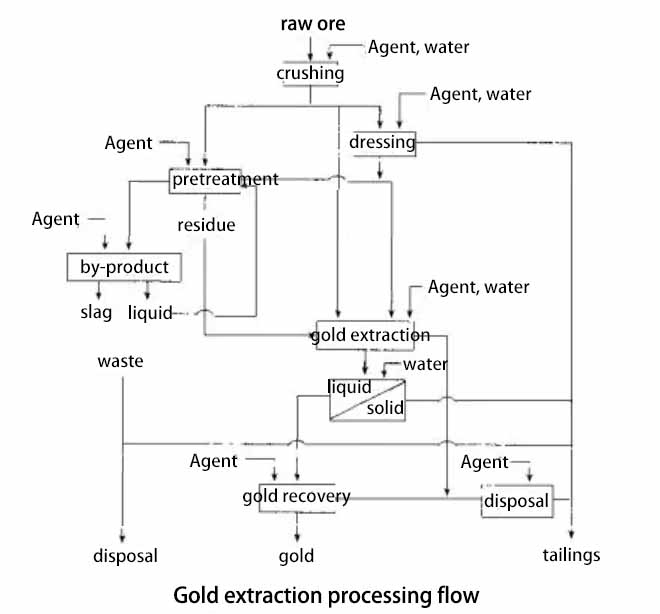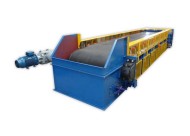Gold exists in a variety of ores with complicated mineralogical properties, so there are many options for ore processing and gold recovery. This paper only deals with some of the processes used in the gold processing plant for the recovery of gold, only apply on the sulphide gold ore which is easy to separate, difficult to leach. However, those of the environmental issues discussed are applicable to the almost gold plant.
The general processing flow of recovering gold from the easy separated, difficult leached sulphide ores is shown below.
Get more info about gold beneficiation processing? gold process methods, equipment, layout ⇒ engineer team is here to help
Gold extraction processing flow
In this process, the ore is first crushed and ground to specified particle size. The ground ore can be sent directly to extract gold or beneficiated, flotation separation and gravity separation are the most used methods. The obtained concentrate and the tailings are disposed of separately.
For refractory ores, pretreatment is required. In order to release gold from sulfide ore bodies, such as pyrite and arsenopyrite, oxidative pretreatment (such as burning, pressure oxidation or bio-oxidation) is generally employed. The refractory ore can be enriched by flotation before oxidation. The oxidation process produces by-products that must be specialized processed prior to the next step.
The classic method of extracting gold is to first dissolve it with a cyanide solution, then replace the gold with the metal from the gold-containing solution, or adsorb it by the carbon slurry method, and then recover the gold from the carbon. The residual cyanide should be removed before returning or discharging the lean liquid to the environment.
All of the processing operations mentioned above have a potential impact on the environment and must be considered during the working flow design phase. For example, noise, dust, smoke, chemical reagent, liquid, solid waste and so on.
Environment considerations
- Crushing and grinding
The crushing and grinding process of the ore produces noise and dust, which mainly affects the environment of the workplace. Sometimes, a reagent such as cyanide is added to the grinding circuit to promote the dissolution of gold, and the added reagent also has an effect on the working environment. - Gold ore dressing
In the flotation process, the potential source of environmental impact is mainly chemical reagents, which may affect the field and the surrounding environment. The flotation tailings is related to some of the following issues
(1) Acidic effluent water
(2) Soluble metal leakage and surface loss
(3) Drainage water turbidity - Pretreatment
Pretreatment of gold ore and concentrate, usually using oxidation to decompose gold-bearing sulfide minerals such as pyrite and arsenopyrite. The oxidation products are treated to comply with environmental protection related to waste disposal regulations. In the case of calcination, the sulfur dioxide and arsenic-containing gases produced by it cannot be directly discharged into the atmosphere.
These oxidation products can be removed by flotation, and gold tailings or oxidation products need to be transported to a remote site for special disposal. - Extraction of gold
A common method of gold extraction is to dissolve the gold ore in an alkaline solution of cyanide. In any case, for the environmental protection of the workplace, the storage and disposal of the reagents should be seriously considered. The waste slag after gold extraction can be disposed of together with flotation tailings. These solids may contain some residual leaching agents. Related post: Gold Extraction Methods Summary - Gold recovery
recover gold from the cyanide solution, the gold can be adsorbed on the activated carbon during the extraction process (CIL) or after the extraction (CIP) or replaced with metal zinc in the displacement precipitation system.
the gold can be adsorbed on the activated carbon during the extraction process (CIL) or after the extraction (CIP) or replaced with metal zinc in the displacement precipitation system. - Tailings disposal
There are many options for tailings disposal, such as sealing ponds, decanting ponds, discharging into beaches and lakes, ground deposit, marine disposal, backfilling, dry landfills, etc. This is related to the choice of the best disposal method and the site holding point, and also depends on the distance from the residential area, terrain, hydrology, local regulations, tailings characteristics and real estate management policies. - Reagent transport and storage
Reagent transport and storage is an important consideration in any study and should be addressed during the metallurgical process design phase. The transportation and storage of reagents, as well as contingency plans, should be considered in detail.
JXSC, a gold mining machine manufacturer, has been supplying gold processing plant equipment and solutions for more than 35 years, always growing and improving in the knowledge and experience among river gold, alluvial gold, sand gold, placer gold, and other minerals.
LATEST PRODUCTS
Belt Feeder
【Capacity】 10-450 t/h 【Power】 1.5-2.5 kW/Mete…
Twin Screw Feeder
【Feeding Capacity】 10-160 t/h【Power】 2.2-…
Tubular Screw Conveyor
【Capacity】6-50 m3/h【Procesible Material】 …










